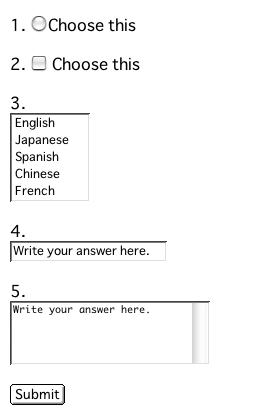
Presenters
Keiko Schneider, Saboten Web Design(kschnei@sabotenweb.com)
Yasuhiro Omoto, University of California, Berkeley
(yomoto@nihongoweb.com)
Satoru Shinagawa, University of Hawaii, Kapiolani CC (satoru@shinagawa.us)
Session Abstract
This session will identify technological and pedagogical issues with assessment in using Internet Technologies. It includes authentic materials and communication, using Internet activities in traditional class and online only class. The session hopes to address curriculum goals and extracting achievable objectives for activity/class basis and assessment with clear focus.
This handout in print and on-line is copyrighted to Keiko Schneider 2003.
Presentation Abstract
Assessment is one of the most crucial processes in language classroom. Unfortunately when technology is involved, often teachers are not necessarily involved in the decision making process regarding what to do and how to do. When that happens, there is a danger that the activities lose focus on instructional objectives. Without clear objectives, assessment cannot be done. Just as any class activities, objectives that are based on curriculum goals should come first in designing Internet class activities. Internet provides instant access to authentic materials and realia from Japan, which otherwise is impossible for JFL teachers, living thousands of miles away from Japan. Studies also show the Internet is an excellent source of understanding culture and it provides opportunities for authentic communication. Dealing with real-life, authentic materials is the ultimate goal of building communication skills in language class, but careful planning is required with clear focus. Some of us are used to textbook-base curriculum where goals and assessment are provided. It is important to provide training for teachers to utilize Internet activities in pedagogical foundation as well as technology tips.

Advantages
1. Automatic or easy to score
2. Data stored on the server or sent to the teacher as e-mail
3. Instant feedback if you like
4. Can make it repeatable for practice if you like
5. Flexible/Programmable
Disadvantages
1. Server goes down/Technical problem
2. Recognition rather than production
3. Verifying may be problematic
4. Non-Roman script problem (display and verify)
5. JavaScript may reveal the answers
1) Beginning of the Semester Questionnaire
2) Writing Kanji (Chinese characters)
3) Verb Conjugation
4) Vocabulary
5) Dialog Oral Practice
6) Reading Comprehension Check
7) Listening Comprehension Check
8) Role Play
9) Composition Homework
Students Will Be Able To:
Good or Bad?
Students Will Be Able To:
- collect five katakana words from the McDonald’s menu page and identify how it is translated into English.
- understand the gist of keypal’s message.
- take a position of either for or against the article and explain why.
- describe your hobbies to your keypal.
Fairfax County Public Schools - PALS: Performance Assessment for Language Students
http://www.fcps.k12.va.us/DIS/OHSICS/forlang/PALS/rubrics/
copyright 2003 Keiko Schneider